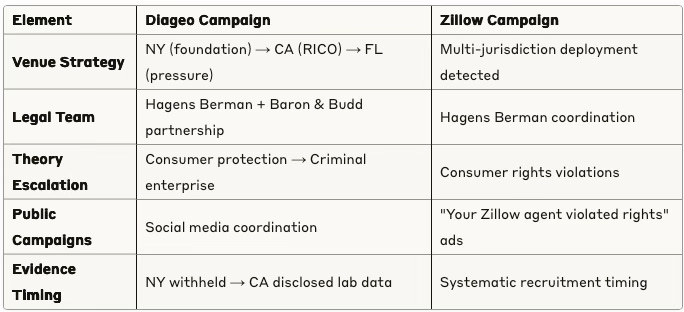MCAI Lex Vision: When AI Meets the Law- How Pattern Recognition is Exposing Hidden Litigation Strategies
How AI reveals coordinated litigation architectures invisible to traditional case-by-case analysis
I. The Discovery: AI Detects What Courts Cannot See
In May 2025, Hagens Berman filed a class action against Diageo in New York federal court. By July, they escalated to RICO charges in California while launching a parallel case in Florida. To most observers, this looked like aggressive but standard litigation.
What they couldn't see was the architecture.
AI changes everything. While courts examine cases individually, AI can detect patterns across jurisdictions and time periods that reveal systematic coordination. MindCast AI, a predictive cognitive AI platform, developed technology that identifies "sophisticated litigation engineering"—coordinated legal campaigns designed to extract settlements through procedural manipulation rather than factual resolution.
The discovery becomes high-stakes when you realize it's happening in real-time. As MindCast AI documented the Diageo pattern, Hagens Berman was simultaneously orchestrating an identical campaign against Zillow—complete with sponsored Facebook ads targeting "Zillow agents" with messages that "Your Zillow agent may have violated your consumer rights." This isn't historical analysis—it's live detection of systematic litigation engineering as it unfolds.
Contact mcai@mindcast-ai.com to partner with us in predictive cognitive AI.
II. The Technology: Beyond Traditional Legal Analysis
MindCast AI's breakthrough rests on a USPTO provisional patent (April 2025) for "Cognitive Digital Twins"—AI models that simulate institutional decision-making to predict behavior and detect coordination.
How It Works:
Signal Trust Model: Filters inputs for reliability and context
Decision Engine: Processes information using structured frameworks
Forecasting Engine: Applies probability analysis and scenario modeling
Feedback Loop: Learns from outcomes to improve detection
Applied to litigation, this system processes court filings, timing sequences, legal team coordination, and public communications to identify patterns that exceed statistical probability for independent case development. Unlike traditional analysis that examines individual cases, MindCast AI reveals institutional architecture underlying multi-case campaigns.
The innovation enables early detection of coordinated strategies, allowing courts to implement oversight before systematic gaming undermines judicial processes.
III. Case Study: Real-Time Detection of Coordinated Litigation Architecture
Coordination Patterns Detected
The Diageo Pattern: Hagens Berman filed in New York (May 2025) withholding lab data, escalated to RICO in California (July 2025) with specific test results, while launching parallel pressure in Florida. Each venue served a strategic purpose: New York for discovery time, California for treble damages, Florida for jury pressure.
The Zillow Campaign: While analyzing Diageo, MindCast AI discovered identical architecture deploying against Zillow. Sponsored Facebook ads appeared targeting "Zillow agents" with "Discover My Rights" messaging, demonstrating the same integration of litigation with public pressure campaigns.
Live Pattern Recognition: Social media posts linked the campaigns: "Hagens Berman? Same law firm suing Diageo?" This was live detection of systematic litigation engineering as it unfolded.
IV. The Broader Pattern: Live Systematic Campaign Deployment
The simultaneous deployment across multiple industries reveals systematic replication rather than case-specific strategy:
Industries Targeted: Spirits (Diageo), Real Estate Platforms (Zillow), Listing Services (NWMLS) Timing: All campaigns active simultaneously in 2025 Architecture: Identical coordination patterns across unrelated markets
The Zillow Class Action Orchestration: Sponsored Facebook ads represent classic class action recruitment—systematic outreach to identify potential claimants rather than response to organic complaints. The "Discover My Rights" messaging with direct links to hbsslaw.com/Z demonstrates proactive campaign deployment.
Predictive Validation: MindCast AI's Diageo analysis enabled recognition of identical architecture deploying against Zillow, demonstrating genuine pattern recognition capabilities.
V. What This Means for the Legal System
For Courts: AI provides tools to address coordination that exploits case-by-case oversight. Courts possess response mechanisms—Rule 11 sanctions, Section 1927 liability, MDL consolidation—but only when coordination patterns are recognized.
For the Legal Profession: The documented integration of litigation with targeted social media recruitment raises questions about boundaries between advocacy and systematic procedural gaming. When coordination architecture appears simultaneously across spirits, real estate, and platform litigation, it indicates institutional adoption that threatens federal court integrity.
Detection Changes Everything: Identifying coordinated campaigns enables courts to respond before systematic gaming achieves settlement objectives. When AI detects Facebook campaigns coordinated with federal filings, it provides transparency into strategies that previously operated below judicial oversight.
VI. The Future: AI as Legal System Guardian
Pattern recognition represents a pivotal moment for federal court oversight. The simultaneous orchestration against Diageo and Zillow demonstrates the sophistication of modern litigation engineering and the need for enhanced detection.
Immediate Implications: Courts facing individual Hagens Berman cases should be aware they may be participating in systematic coordination invisible to traditional oversight. When judges see sponsored social media recruiting claimants during litigation, they have concrete evidence of coordination extending beyond normal advocacy.
Real-Time Response: AI detection enables courts to identify and address coordinated campaigns during early evaluation rather than after systematic gaming achieves settlement extraction. This transforms judicial oversight from reactive to proactive.
VII. Conclusion: The Promise of Transparent Justice
The intersection of artificial intelligence and litigation analysis offers unprecedented opportunity to restore integrity to complex federal court processes—and the urgency is immediate. MindCast AI's pattern recognition technology has demonstrated real-time detection of coordinated litigation campaigns, including active class action orchestration against major corporations through integrated social media recruitment and multi-jurisdiction filing strategies.
The Current Moment: As this analysis is published, Hagens Berman's sponsored Facebook ads continue targeting potential Zillow claimants while their systematic campaign architecture deploys across multiple federal courts. This isn't historical analysis of past litigation abuse—it's live documentation of systematic engineering as it unfolds, providing courts and oversight authorities with unprecedented transparency into coordination previously invisible to traditional judicial oversight.
The Immediate Choice: Federal judges currently managing individual Hagens Berman cases now possess concrete evidence of systematic coordination that extends far beyond traditional advocacy. Courts can implement enhanced case management, consider consolidation, or apply appropriate sanctions with full knowledge of the institutional architecture underlying seemingly independent litigation.
The documented coordination across spirits, real estate, and platform litigation illustrates both the sophistication of modern litigation engineering and the power of AI detection to illuminate systematic strategies in real-time. As courts and legal institutions respond to these technological capabilities, pattern recognition may become essential infrastructure for maintaining litigation integrity in an era of systematic campaign deployment against major corporations.
The Promise of Immediate Transparency: AI pattern recognition offers courts, legal professionals, and oversight authorities tools to choose transparency, efficiency, and integrity over institutional manipulation and settlement extraction—not in future cases, but in litigation currently unfolding across federal courts. When AI meets the law in real-time, the result should be immediate enhancement of judicial oversight that serves both legal professionals and the public they represent, creating accountability for systematic coordination that operates across multiple major litigation campaigns simultaneously.




